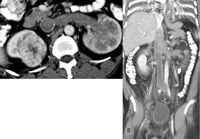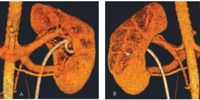Article
How to use 3-D CT as a planning tool for renal surgery
Radiologic imaging has always played a critical role in the diagnosis, treatment, and follow-up of urologic disease. Advances in three-dimensional imaging using multidetector computerized tomography (MDCT) have made this imaging modality an invaluable diagnostic tool in many aspects of urologic practice.
Radiologic imaging has always played a critical role in the diagnosis, treatment, and follow-up of urologic disease. Advances in three-dimensional imaging using multidetector computerized tomography (MDCT) have made this imaging modality an invaluable diagnostic tool in many aspects of urologic practice.
Multidetector CT allows for isotropic volumetric data acquisition during a single breath-hold. High-performance 3-D workstations are then used to manipulate and reformat collected data into 3-D images in any plane while maintaining spatial resolution.
MDCT with 3-D image post-processing offers the advantage of providing, in a single 3-D image, the information provided by conventional CT, angiography, venography, and excretory urography. These images can be saved on compact disc, which can then be reviewed and manipulated by the urologist in the office and referenced in the operating room.
Partial nephrectomy

The location of the tumor in relation to the renal vasculature and collecting system assists the surgeon in planning the surgical approach and identifying normal renal parenchyma. Also, the need for vascular clamping and preoperative stenting can be addressed as radiologic tumor margins are defined. 3-D CT is accurate in the determination of tumor margins when preoperative 3-D CT findings are compared with location and margin status on pathologic specimens (BJU Int 2000; 86:777). The additional precise information gleaned from the 3-D CT is all the more indispensable for the laparoscopic surgeon undertaking partial nephrectomy.
UPJ obstruction


Donor nephrectomy
Preoperative evaluation of potential kidney donors involves imaging of the kidneys to determine renal anatomy. The location, length, and number of renal arteries and veins contributes valuable information in the decision-making process.
In addition to being less expensive than the combination of a traditional arteriogram and standard CT, 3-D CT offers the advantage of being a noninvasive method of evaluating the renal vasculature. 3-D CT is highly sensitive in the identification of multiple renal arteries and veins (J Urol 2003; 170:57). When performed with and without IV contrast, stone disease can be ruled out in the potential donor and the renal anatomy evaluated.
Stone disease
Although most renal stones do not require 3-D CT imaging, additional information may be obtained utilizing this modality when necessary. An accurate measurement of stone size, as well as the spatial relationship of calculi within collecting system, can be achieved.
Conclusion
3-D CT has become an effective noninvasive imaging modality for evaluating patients with urologic disease. It provides the surgeon with accurate information that can be utilized in the diagnosis and treatment of renal tumors and UPJ obstruction and the preoperative evaluation of kidney donors. As this technology becomes readily available to all urologists, its use is likely to become as commonplace as many of the traditional imaging methods we now use on a daily basis.
Newsletter
Stay current with the latest urology news and practice-changing insights — sign up now for the essential updates every urologist needs.















